ARS ELECTRONICA ARCHIVE - PRIX
Der Prix Ars Electronica Showcase ist eine Sammlung, innerhalb derer die Einreichungen der KünstlerInnen zum Prix seit 1987 durchsucht und gesichtet werden können. Zu den Gewinnerprojekten liegen umfangreiche Informationen und audiovisuelle Medien vor. ALLE weiteren Einreichungen sind mit den Basisdaten in Listenform recherchierbar.
Luxo Jr.
John Lasseter
105283Original: ENT_8726a_AEC_PRX_1987_luxo_jr _1404393.avi | 720 * 576px | 1m 32s | 335.5 MB
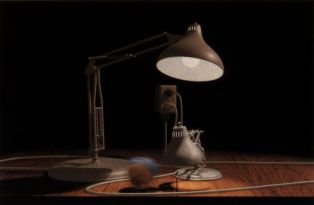
Original: PR_1987_luxo_001_o.jpg | 314 * 205px | 189.0 KB
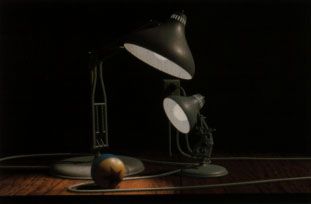
Original: PR_1987_luxo_002_o.jpg | 311 * 204px | 186.5 KB
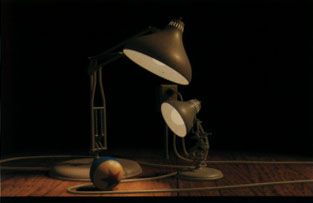
Original: PR_1987_luxo_003_o.jpg | 313 * 203px | 18.6 KB
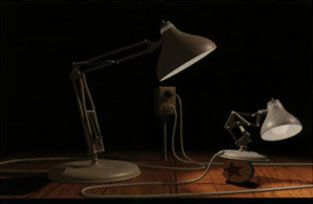
Original: PR_1987_luxo_004_o.jpg | 313 * 204px | 18.8 KB
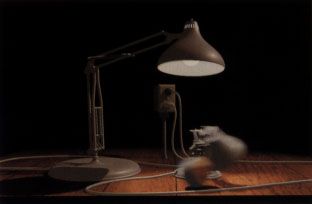
Original: PR_1987_luxo_005_o.jpg | 312 * 204px | 186.5 KB
"Luxo Jr." - Kurzbeschreibung
Ein paar Jazzklavier - Riffs plätschern gemächlich dahin, als ein kleiner bunter Gummiball auf eine Schreibtischlampe zurollt. Die metallene Lampe scheint den Ball gedankenversunken zu studieren, dann schlägt sie ihn mit ihrem Lampenschirm weg. Der Ball kommt wieder. Die Lampe schlägt den Ball wieder fort, und nochmals kommt der Ball zurück, diesmal verfolgt von einem fröhlich quietschenden Lämpchen. Wild schwankend, zielt Schreibtischlampe d. J. mit dem Ball nach Papa Lampe, aber der Ball verfängt sich im Kabel des Juniors und bleibt liegen. Geduldig schiebt der Vater den Ball wieder zu seinem Sohn hin.
Schwungvoll und eifrig springt der Junior auf den Ball und beginnt, auf ihm herumzuschaukeln. Plötzlich zerplatzt der Ball, und die Luft geht ihm aus. Traurig und reuevoll blickt der Junior fragend zum Vater, und dieser bestätigt mit einem Nicken, daß der Ball in den Himmel aller Gummibälle eingegangen ist. Voller Trauer sinkt Junior in sich zusammen. Verständnisvoll nickt Vater Schreibtischlampe seinem Sohn zu, und dieser hoppelt enttäuscht weg.
Und plötzlich - da muß Papa Lampe zurückspringen, um einem dahersausenden Wasserball auszuweichen, dem der Junior jubilierend nachhüpft. Und Papa Lampe schüttelt seufzend seinen Lampenschirm.
"Luxo Jr." ist eine preisgekrönte Computeranimation aus der Werkstätte von PIXAR in San Rafael. Der Film betritt insofern Neuland, als er unbelebte Objekte mit Persönlichkeit erfüllt und mittels Computertechniken Emotionen mitteilt.
John Lasseter, ehemaliger Disney-Mitarbeiter, gibt im Verein mit Bill Reeves, Eben Ostby und Sam Leffler den beiden Luxo-Schreibtischlampen die emotionale Ausstrahlung einer Vater-Sohn- Beziehung. Die Lampen spielen friedlich mit einem Gummiball, bis Luxo Juniors Spielzeug plötzlich zerplatzt. Der Film drückt Mitleid und Reue durch die simplen Wellenbewegungen eines Lampenkabels und das Nicken des metallenen Lampenschirmes aus.
Für diesen Film entwickelte PIXAR verschiedene technische Neuerungen, deren bemerkenswerteste wohl das "self-shadowing" ist, bei dem ein Objekt automatisch und genau den Schattenwurf auf sich selbst steuert. Der Film wurde mittels keyframe-Animation-Systemen und mit der Unterstützung von procedural animation generiert, die Bildgestaltung schließt mehrfache Lichtquellen und procedural-texturing-Techniken ein. Die Rechenarbeit erfolgt auf vier Computer Consoles Power 6/32 Computern namens Mickey, Donald, Manet und O'Keefe. Der Film wurde erstmals im August 1986 bei SIGGRAPH in Dallas unter dem Beifall von 6000 Computerexperten gezeigt. Diese enthusiastische Aufnahme veranlaßte „ Time" in der Nummer vom 1. 9.1986 einen Bericht über den Film und PIXAR zu bringen. „Luxo Jr. “ wurde für den Academy Award (Oscar) für den besten Kurz-Trickfilm nominiert und bei den Berliner Film festspielen, dem Canadian International Festival of Animation, dem San Francisco International Film Festival und beim internationalen Forum „ Neuer Film" in Monte Carlo gezeigt.
Pixar, identisch mit der ehemaligen Computergraphik- Abteilung von Lucasfilm, wurde 1986 von Steven P. Jobs und den Pixar Mitarbeitern erworben.
Statement
Ich habe die handelnden Figuren, die Dekoration, den Hintergrund entworfen und das Ganze inszeniert. Mit Sam Leffler gemeinsam ist dann jede Aktion zerlegt worden, so daß der Computer sie verstehen konnte, wir haben auch seine Arbeit ständig überwacht und mehrmals eingegriffen.
Es wäre lächerlich zu glauben, der Animator müßte nun auch Informatiker werden, dazu bräuchte er ein zweites Leben. Genauso dumm wäre es anzunehmen, ein Informatiker könnte sich in einen Animator verwandeln, man weiß ja, wie lange so etwas dauert. Natürlich ist es unerläßlich, daß der Animator ein wenig sein elektronisches Werkzeug kennt, dessen Arbeitsweise, dessen Logik. Sofern man nicht wirklich sehr schwer von Begriff ist, lernt man das leicht, und das ist die Basis, um die Fähigkeiten und Grenzen des Werkzeuges bewerten zu können, und natürlich, um mit den Technikern zu kommunizieren.
Ein paar Jazzklavier - Riffs plätschern gemächlich dahin, als ein kleiner bunter Gummiball auf eine Schreibtischlampe zurollt. Die metallene Lampe scheint den Ball gedankenversunken zu studieren, dann schlägt sie ihn mit ihrem Lampenschirm weg. Der Ball kommt wieder. Die Lampe schlägt den Ball wieder fort, und nochmals kommt der Ball zurück, diesmal verfolgt von einem fröhlich quietschenden Lämpchen. Wild schwankend, zielt Schreibtischlampe d. J. mit dem Ball nach Papa Lampe, aber der Ball verfängt sich im Kabel des Juniors und bleibt liegen. Geduldig schiebt der Vater den Ball wieder zu seinem Sohn hin.
Schwungvoll und eifrig springt der Junior auf den Ball und beginnt, auf ihm herumzuschaukeln. Plötzlich zerplatzt der Ball, und die Luft geht ihm aus. Traurig und reuevoll blickt der Junior fragend zum Vater, und dieser bestätigt mit einem Nicken, daß der Ball in den Himmel aller Gummibälle eingegangen ist. Voller Trauer sinkt Junior in sich zusammen. Verständnisvoll nickt Vater Schreibtischlampe seinem Sohn zu, und dieser hoppelt enttäuscht weg.
Und plötzlich - da muß Papa Lampe zurückspringen, um einem dahersausenden Wasserball auszuweichen, dem der Junior jubilierend nachhüpft. Und Papa Lampe schüttelt seufzend seinen Lampenschirm.
"Luxo Jr." ist eine preisgekrönte Computeranimation aus der Werkstätte von PIXAR in San Rafael. Der Film betritt insofern Neuland, als er unbelebte Objekte mit Persönlichkeit erfüllt und mittels Computertechniken Emotionen mitteilt.
John Lasseter, ehemaliger Disney-Mitarbeiter, gibt im Verein mit Bill Reeves, Eben Ostby und Sam Leffler den beiden Luxo-Schreibtischlampen die emotionale Ausstrahlung einer Vater-Sohn- Beziehung. Die Lampen spielen friedlich mit einem Gummiball, bis Luxo Juniors Spielzeug plötzlich zerplatzt. Der Film drückt Mitleid und Reue durch die simplen Wellenbewegungen eines Lampenkabels und das Nicken des metallenen Lampenschirmes aus.
Für diesen Film entwickelte PIXAR verschiedene technische Neuerungen, deren bemerkenswerteste wohl das "self-shadowing" ist, bei dem ein Objekt automatisch und genau den Schattenwurf auf sich selbst steuert. Der Film wurde mittels keyframe-Animation-Systemen und mit der Unterstützung von procedural animation generiert, die Bildgestaltung schließt mehrfache Lichtquellen und procedural-texturing-Techniken ein. Die Rechenarbeit erfolgt auf vier Computer Consoles Power 6/32 Computern namens Mickey, Donald, Manet und O'Keefe. Der Film wurde erstmals im August 1986 bei SIGGRAPH in Dallas unter dem Beifall von 6000 Computerexperten gezeigt. Diese enthusiastische Aufnahme veranlaßte „ Time" in der Nummer vom 1. 9.1986 einen Bericht über den Film und PIXAR zu bringen. „Luxo Jr. “ wurde für den Academy Award (Oscar) für den besten Kurz-Trickfilm nominiert und bei den Berliner Film festspielen, dem Canadian International Festival of Animation, dem San Francisco International Film Festival und beim internationalen Forum „ Neuer Film" in Monte Carlo gezeigt.
Pixar, identisch mit der ehemaligen Computergraphik- Abteilung von Lucasfilm, wurde 1986 von Steven P. Jobs und den Pixar Mitarbeitern erworben.
Statement
Ich habe die handelnden Figuren, die Dekoration, den Hintergrund entworfen und das Ganze inszeniert. Mit Sam Leffler gemeinsam ist dann jede Aktion zerlegt worden, so daß der Computer sie verstehen konnte, wir haben auch seine Arbeit ständig überwacht und mehrmals eingegriffen.
Es wäre lächerlich zu glauben, der Animator müßte nun auch Informatiker werden, dazu bräuchte er ein zweites Leben. Genauso dumm wäre es anzunehmen, ein Informatiker könnte sich in einen Animator verwandeln, man weiß ja, wie lange so etwas dauert. Natürlich ist es unerläßlich, daß der Animator ein wenig sein elektronisches Werkzeug kennt, dessen Arbeitsweise, dessen Logik. Sofern man nicht wirklich sehr schwer von Begriff ist, lernt man das leicht, und das ist die Basis, um die Fähigkeiten und Grenzen des Werkzeuges bewerten zu können, und natürlich, um mit den Technikern zu kommunizieren.
John Lasseter: direction, animation, models
Bill Reeves: technical direction, models, rendering
Eben Ostby: models, procedural animation, rendering
Sam Leffler: rendering
Rob Cook: rendering
Don Conway: laser output scanning
Bill Reeves: technical direction, models, rendering
Eben Ostby: models, procedural animation, rendering
Sam Leffler: rendering
Rob Cook: rendering
Don Conway: laser output scanning
John Lasseter (USA), 1957 in Los Angeles geboren, ist ein typischer Vertreter jener ersten Generation, die mit dem Fernsehen aufgewachsen ist. Nach einer Ausbildung in klassischer Zeichenanimation am renommierten California Institute of the Arts beginnt er als knapp Zwanzigjähriger seine Berufslaufbahn als Zeichner bei Walt Disney. Dort, wo er unter anderem an den Zeichentrickfilmen"The Fox and the Hound" und "Mickey's Christmas Carol" mitarbeitet, kommt John Lasseter erstmals mit der Computeranimation in Berührung. Dies vor allem durch seine Mitarbeit an den Filmen "Wild Things Test" und "Tron". "Wild Things Test" war der erste Versuch händisch gezeichnete Charakteranimation und computergenerierten Hintergrund zu verbinden. "Tron" ging als erster digitaler Spielfilm, der Schauspieler in computergenerierter Szenerie agieren läßt, in die Filmgeschichte ein. Von den Walt Disney Productions wechselte John Lasseter 1984 zur Computer Division von Lucasfilm, wo er unter anderem den berühmten"glass man" - eine computergenerierte Figur - für den Spielberg-Film "Young Sherlock Holmes" entwirft und animiert. Aus der Computer-Abteilung von Lucasfilm entwickelt sich Pixar als eigenständiges Unternehmen, das in kurzer Zeit mit seinen Entwicklungen in Graphiksoftware zur Weltelite zählt. Für PIXAR produziert er 1985 "The Adventures of André and Wally B." und "Luxo jr." die erste Computeranimation, die in der Kategorie Kurzfilm für den Oscar nominiert. 1987 entsteht Red's Dream , der seit seiner Uraufführung bei der SIGGRAPH 87 eine Reihe von Preisen erhält.


